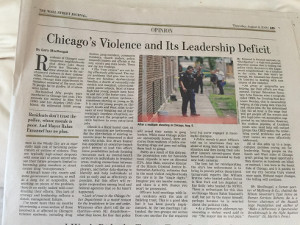The Wall Street Journal
August 8, 2018
By GARY E. MACDOUGAL

Residents of Chicago’s most dangerous neighborhoods shut down Lake Shore Drive last Thursday to draw attention to the out-of-control violence in their communities. Underlining their urgent concerns, Chicago then experienced its bloodiest weekend of the year, with 74 people hit by gunfire, 12 of whom were killed.
Six-hundred fifty people were murdered in Chicago last year. This exceeds the number in New York (290) and Los Angeles (282) combined. An estimated 3,000 young men in the Windy City are at especially high risk of becoming perpetrators or victims of violence. They are typically high-school dropouts with some sort of prison record who see their future prospects limited to becoming gang members or street corner drug “entrepreneurs.”
Although many city, county and state government agencies, as well as a long list of nonprofits, are working on pieces of the problem, there is no entity tasked with coordinating their efforts. This lack of strategy and leadership reflects a classic management failure.
I’ve spent more than six months interviewing a cross-section of those involved in or affected by Chicago’s violence epidemic, including drug dealers, gang members, community residents, church leaders, police, nonprofit leaders and officials at the city, county and state levels. These are my key findings.
• The “root causes” are not being effectively addressed. The major problems that give rise to violence are familiar: dysfunctional families, a dearth of successful role models and marginal, union-dominated public schools. Most of these high-risk young people have been in and out of the foster-care, juvenile-justice and prison systems—sometimes starting as young as 10. It is easy for young people on Chicago’s South and West sides to despair of ever breaking out of their seemingly hopeless situations, especially given the geographic and skills barriers to even entry-level jobs.
Illinois is a fiscal basket case, so no new resources are forthcoming. But the distribution of existing resources must be reassessed to deal with this crisis. Gov. Bruce Rauner has appointed an executive-branch point person to lead this effort. Some possibilities include focusing resources such as mental-health services on individuals in troubled areas, making connections between troubled youth and potential employers, and better data-sharing to identify and help individuals at risk as early and as effectively as possible. But this effort will require cooperation among local and federal agencies that so far hasn’t happened.
• Lack of trust in the Chicago Police Department is a major reason for the breakdown in law and order. Witnesses often don’t tell the authorities—even 911 dispatchers—what they know, for fear that police will reveal their names to gang leaders. While most Chicago police are undoubtedly honest, there are stories from residents of police confiscating drugs and guns and selling them back to gangs.
Partly as a result of this distrust, the prosecution rate for homicide cases citywide is now an abysmal 17.5%. John Maki, executive director of the Illinois Criminal Justice Information Authority, estimates that in the most violent neighborhoods the rate is in the “single digits.” Imagine: you can murder someone, and there is a 90% chance you won’t be prosecuted.
Officers hold meetings with local residents with the aim of building trust. This is a good idea but it has been poorly implemented. At the two meetings I attended, the two groups sat across from one another for the required hour but never engaged in meaningful dialogue.
• Police morale is poor. Officers told me in interviews they are afraid of doing their best in a tough situation and then losing their jobs after lawyers second-guess them based on footage recorded by their new body cameras.
The best bet for reinvigorating the city’s law enforcement is to bring in proven police department turnaround experts like William Bratton (who headed police forces in New York and Los Angeles) or Ray Kelly (who headed the NYPD). There is enthusiasm for this idea on Chicago Mayor Rahm Emanuel’s staff, but not by the mayor himself, perhaps because he is worried about the political risks.
• As a Democratic alderman representing a violent ward said to me: “The mayor has no real plan.” Mr. Emanuel is focused narrowly on “ShotSpotter”—a high-tech gunshot detection system that is helping the police catch shooters in the Englewood neighborhood—as a solution to the crisis. But this won’t be enough. Mr. Emanuel has shown little interest in dealing with root causes of the violence.
• An array of nonprofits are helping, but their efforts are fragmented. Former Education Secretary Arne Duncan runs a nonprofit called CRED, for Creating Real Economic Destiny, that is successfully helping at-risk young men train for and obtain jobs. He has determined that $15 an hour is the wage that will get people off the streets and into legal jobs—an assumption supported by my interviews. However, the endless pipeline of troubled youth who need help will outlast groups like CRED unless the underlying social problems and police trust issues are more effectively addressed.
All of this adds up to a large, complex problem crying out for leadership. Young people on the South and West sides of Chicago aren’t getting the equal opportunity they deserve as hundreds are killed or maimed. I was born in the South Side of Chicago, and it is painful to see my city become truly violent once again. Without major changes, the killing will continue.
Mr. MacDougal, a former partner of McKinsey & Co., chaired the Illinois Governor’s Task Force on Human Services Reform. He is a former chairman of the Russell Sage Foundation and author of “Make a Difference: A Spectacular Breakthrough in the Fight Against Poverty” (St. Martin’s Press).
Appeared in the August 9, 2018, print edition.